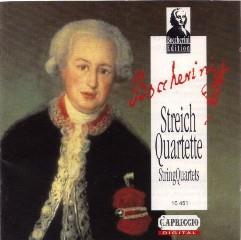Boccherini – Streich Quartette (String Quartets) (1991)
Boccherini – Streich Quartette (String Quartets) (1991)

Streichquartett Nr.90 F-Dur, Op.64 Nr.1 G.248 1 Allegro Molto 7:19 2 Adagio Non Tanto 7:21 3 Allegro Vivo Ma Non Presto 4:12 Streichquartett Nr.19 D-Dur, Op.15 Nr.1 G.177 4 Presto 5:43 5 Allegro Rondeau 2:27 Streichquartett Nr.36 G-Moll, Op.24 Nr.6 G.194 6 Allegro Vivo Assai 4:58 7 Adagio 5:36 8 Minuetto - Trio 4:23 Streichquartett Nr.55 A-Dur, Op.39 G.213 9 Allegro Moderato 7:42 10 Minuetto - Trio 3:02 11 Grave 4:16 12 Allegro Giusto 4:42 Petersen Quartett: Ulrike Petersen - I violin Gernot Süssmuth - II violin Friedemann Weigle - viola Hans-Jakob Eschenburg - cello
Joseph Haydn is usually regarded as the father of the string quartet. However, Luigi Boccherini wrote his first string quartets in 1761, just predating Haydn’s Op. 1 collection. Boccherini could not have known Haydn’s work, so it would appear that the two composers independently arrived at the same idea. But there can be little doubt that Boccherini was the first to add either a second viola or cello to the standard string quartet to form a string quintet. This double CD with the Petersen Quartet features four each of Boccherini’s string quartets and quintets, making this set a convenient introduction to his chamber music.
Boccherini is a composer who is capable of surprising even when his work seems to be proceeding along a well-trodden path. One of the leading cellists of his day, his virtuoso command of the instrument can be seen in his occasionally very high-lying cello lines. Boccherini’s part-writing is correspondingly less violin-dominated than the early Haydn quartets, all the lines behaving with a great deal of freedom. An example is the first movement of the Quartet no. 36, in which the theme is given a two-part treatment featuring canonic imitation over a pedal point. The violin and cello are often given mini-cadenzas, particularly in the slow movements. Boccherini’s dramatic pauses also recall Haydn, but the flightiness of his music more resembles C.P.E. Bach.
Many of the chamber groups that have recorded Boccherini have done so on original instruments; the Esterhazy Quartet and Europa Galante are two that come to mind. Because the Petersen Quartet - and their guest second viola and cello - play on modern instruments, their sound does not quite have the warmth of these ensembles. Nonetheless the Petersens play with a lightness of touch that shows how well they have thought this music through. Their performances are elegant and sensitive, and all the players get and take their chance to shine; I particularly enjoyed the contributions of their cellist Hans-Jakob Eschenburg. The ensemble’s intonation is impeccable throughout, and the recording has presence without being too close. This set offers very fine quartet and quintet playing, and will please anyone seeking an overview of Boccherini’s chamber music. ---Guy Aron, musicweb-international.com
The average music lover knows only one piece by Boccherini: the famous Menuet. And inded it is quintessential Boccherini, elegant, charming, sweetly melodic, warm, and graceful. However, there is more to this famous classical composer. His vast output of mainly chamber music shows him a genius craftsman, able to express himself in a wide range of emotions, in well balanced and perfected structures of classical style. ---amazon.com
download (mp3 @320 kbs):
